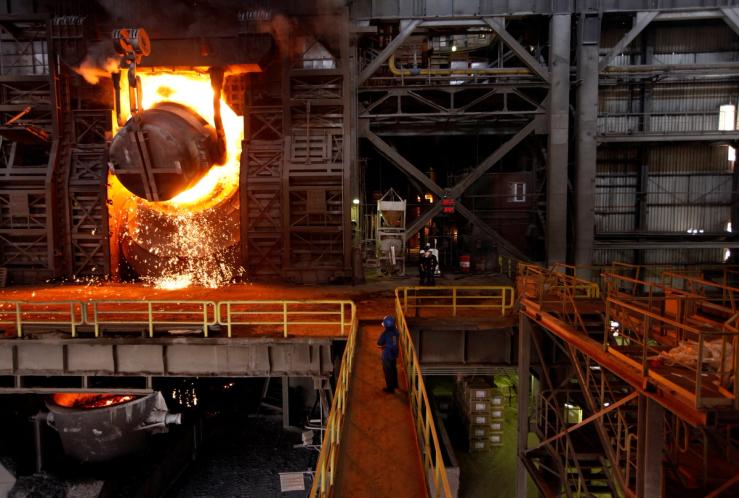The Scoop
One of the world’s biggest private equity firms wants to prove it can turn a hefty profit on the energy transition — but believes explicitly targeting the emissions savings of its investments would actually be counterproductive, its co-head of global climate said in an interview.
The remarks by KKR’s Emmanuel Lagarrigue — he argued emission-reduction goals risked investors over-concentrating on limited technologies, and ultimately undermined the case that the energy transition was sufficiently profitable on its own — came in a wide-ranging conversation setting out KKR’s approach.
Lagarrigue also said the firm is targeting what climate-tech companies call the “valley of death,” with a focus on rich countries. “It’s really about decarbonizing high emission sectors and high emitting economies,” he said.
“When you have completely derisked your technology, you have validated your unit economics, you start generating a few serious cash flows, you have created entry barriers — usually, when you reach that point in climate, you need a lot of money just to get started, just to execute on whatever agreement you just got from your first large customer. And this is where people are stuck,” Lagarrigue told me. “This is where we want to focus our strategy.
In this article:
Prashant’s view
KKR’s strategy as outlined by Lagarrigue hits at two of the central questions underlying our coverage at Net Zero: How does path-breaking climate technology get funded? And is the energy transition lucrative enough to attract investors who just want to make money? The answers to both are critical to accelerating the pace of the transition.
On the first, KKR is the biggest name yet to tackle the valley of death — the point at which climate-focused companies, particularly those that make hardware, often flounder: When they are beyond the scale of earlier-stage venture capital investors, but must still make large capital expenditures to roll out their technology, and yet are unlikely to make hefty profits for years to come as they prove their strategies are viable.
On the second, KKR is again atypical. As Lagarrigue put it, making emissions reductions a metric for the firm’s success along with financial returns “is a risk” on two main levels.
For one, by targeting emissions reductions, he said, investors necessarily gravitate towards particular technologies such as green steel — otherwise highly polluting steel made with energy powered by renewable electricity or green hydrogen — which offers “the best return on CO2 abated per dollar invested,” but results in “a concentration risk in your strategy.” As a result, investors deprioritize other important sectors with hard-to-abate emissions such as agriculture or transportation. In effect, KKR is compromising having the highest-possible emissions impact because doing so would lead to an unbalanced, and therefore too-risky and ultimately potentially unprofitable, portfolio.
On a more rhetorical level, Lagarrigue argued an emissions metric would undermine KKR’s core argument: “What we want to prove and demonstrate here — and we are convinced — it’s that there is no trade off between returns and decarbonization … You have to create an alpha without having to trade off.”
That doesn’t mean KKR doesn’t track emissions: Overall, 96% of emissions from KKR-controlled companies are directly measured, the firm said. “At KKR, we like to work from the bottom up,” Lagarrigue told me. “We are constantly reinforcing the climate reporting of all our strategies, and looking very hard at our emissions, and how we remove those emissions from our portfolio.”
Still, he said, “we’re not sure if [emissions targeting] helps with the idea of ‘No, there’s no trade off between decarbonization [and returns]’,” he said. “It’s intellectually attractive to put a target, a greenhouse gas emission reduction target. But actually, it’s more risk than upside.”
Know More
Lagarrigue offered more detail on the firm’s geographic and thematic focus as well as thoughts on the impact of November’s US presidential election.
Deal Flow
Lagarrigue said KKR would probably strike deals every 3-6 months, likely between $750 million and $1 billion — similar to the two deals it has already announced — targeting higher returns than infrastructure funds but lower than typical private equity investments. (Lagarrigue declined to discuss the ultimate size of the fund that KKR is raising, nor did he comment on how far along KKR was in fundraising, but Reuters reported in December that the firm is seeking to raise up to $7 billion.)
KKR would, he said, impose three tests on the climate credentials of its investments: Is the emissions reduction offered by an investment opportunity relevant (“Are we really solving a problem?“), significant (“Are we really eliminating or reducing the Scope 3 of someone in a value chain?“), and credible (“Can we measure the emissions that we are going to remove, abate, eliminate, replace?“).
Geographies
KKR intends to focus on OECD countries, Lagarrigue said. “There are cases like India or some parts of South America where there’s very interesting things happening and you can really have a contribution to decarbonization. But it’s really about decarbonizing high emission sectors and high emitting economies. The Global South, that’s a different problem, it probably requires a different strategy.”
Sectors
The firm’s strategy will likely drive it to “hard-to-abate sectors,” Lagarrigue acknowledged, specifically pointing to steel, cement, shipping, aviation, and fertilizer, though thus far of its two announced investments, one has been in a California solar-and-storage company while the other has been in a U.K. fleet transportation and battery storage firm.
Technologies
Hydrogen: “Hydrogen is a means to an end, it’s a feedstock. There has been a lot of hype, that hydrogen was going to be the Swiss Army knife for solving everything. No, it’s not the Swiss Army knife of anything.”
Wind: “Wind is very mature. This is why we are very happy to invest in wind in our core infrastructure strategy. … 10 years ago, yes, [you could find high growth in wind] but that’s not happening, and we don’t think that’s going to happen anymore.”
Data Centers: “In a 2050 world where the transition is largely done, where heating is heat pumps, and cars are electric, and buses and everything moving on the ground is electric — in that world — data centers represent 20% of electricity consumption. … And maybe more.”
Political Risk
Climate investors have voiced worry that Donald Trump’s return to the White House could portend a strangling of the Inflation Reduction Act’s largesse, as well as a slowing — or reversal — of any domestic and international climate progress.
Lagarrigue, however, expressed confidence that regardless of who wins the presidential election, the consequences would not be “binary.”
“This is a multi-decade transition,” he said. “So that goes way, way beyond any political cycle, right. So there may be ups and downs, political tailwinds or headwinds, or how fast the new technologies come to fruition.” Ultimately, however, “It’s a long game.”
The View From Israel
The valley of death forces companies down unexpected funding paths in order to stay in business. Brenmiller Energy — an Israeli energy-storage company which was founded more than a decade ago and uses crushed rocks to store heat — IPO-ed on the Tel Aviv stock market in 2017, well before it would have liked, its Chief Business Officer Doron Brenmiller said in an interview. “If we were to have a theoretical discussion, what’s the best timing to IPO, I wouldn’t say when you are far from your substantial revenues” is the best time, he said. “But you need to get what you can, when you can.”
Notable
- Though $7 billion is a huge sum in the world of climate, it is dwarfed by KKR’s other funds: The firm has already raised $11 billion for its latest global infrastructure fund out of a target of $20 billion, according to Bloomberg.


